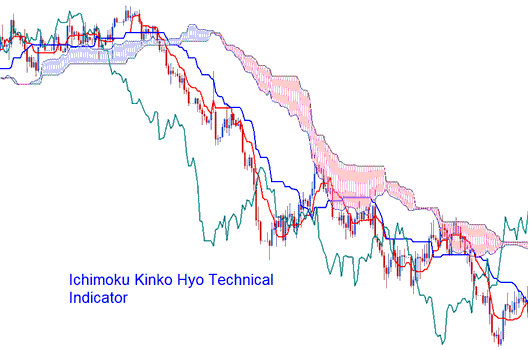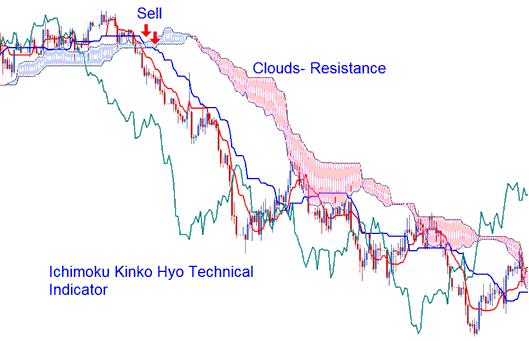Ichimoku Indicator
Ichimoku is a Japanese charting technique that was created before by a Japanese newspaper writer, with the pen name of Ichimoku Sanjin.
- Ichimoku means "a glance" or "one look"
- Kinko means "equilibrium" or "balance"
- Hyo is the Japanese term for "chart"
Thus, Ichimoku means, "a glance at an equilibrium chart". Ichimoku attempts to identify the likely direction of stock index price & help the trader to figure out the most suitable time to enter or exit the market.

Calculation
This technical indicator consists of five lines drawn using the midpoints of previous highs & lows. The five lines are calculated as follows:
1) Tenkan-Sen: Conversion Line: Red Line (Highest High + Lowest Low) / 2, for the last 9 price periods
2) Kijun-Sen: Base Line: Blue Line (Highest High + Lowest Low) / 2, for the last 26 price periods
3) Chikou Span: Lagging Span: Green Line Today's closing stock index price drawn 26 price periods behind
4) Senkou Span A: Leading Span A = (Tenkan Sen + Kijun Sen) / 2, plotted 26 price periods ahead
5) Senkou Span B: Leading Span B: (Highest High + Lowest Low) / 2, for the past 52 price periods, drawn 26 price periods ahead
Kumo: Cloud: area between Senkou Span A and B
Indices Analysis & How to Generate Trade Signals
Bullish signal - Tenkan-Sen crosses Kijun-Sen from below.
Bearish signal - Tenkan-Sen crosses Kijun-Sen from above.
However, there are different levels of strength for the buy and sell stock index trade signals generated.

Technical Analysis in Indices
Bullish crossover signal forms above the Kumo (clouds),
Very strong buy signal.
Bearish cross-over signal forms below the Kumo (clouds),
Very strong sell signal.
If a bullish/ bearish cross-over signal takes place within the Kumo (clouds) it is considered a medium strength buy or sell signal.
A bullish cross-over that occurs below the clouds is considered a weak buy signal while a bearish crossover that occurs above the clouds is considered a weak sell signal.
Support and Resistance Levels
Support and resistance levels can be predicted by the presence of Kumo (clouds). Kumo can also be used to identify the current trend of the market.
- If stock index price is above the Kumo, the prevailing market trend is said to be upwards.
- If stock index price is below the Kumo, the prevailing market trend is said to be downwards.
Chikou Span or Lagging Span is also used to determine the strength of the buy or sell signal.
- If the Chikou Span is below the closing stock index price of the last 26 periods ago and a sell short signal is given, then the strength of the trend is down-wards, otherwise the signal is considered to be a weak sell signal.
- If there is a bullish signal and the Chikou Span is above the price of the last 26 periods ago, then the strength of the trend is to the upside, otherwise it's considered to be a weak buy signal.


